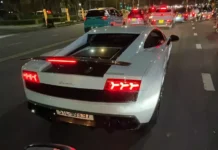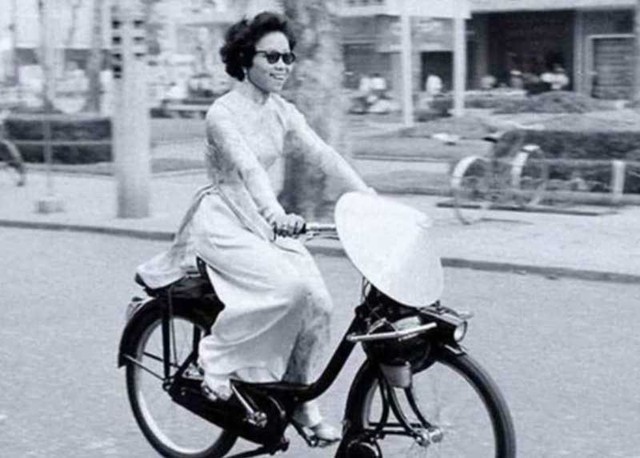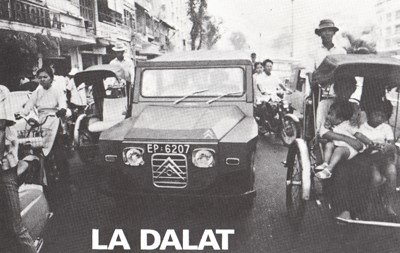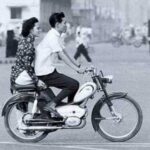The most impressive vehicle for me is probably the Sachs motorcycle. In Tet 1960, when I was 10, the newest model of motorcycle was the Gobel, which belonged to the Sachs line from Germany.
Aside from Gobel, this line also carried two other brands, Ischia and Brumy. Compared to now, this motorcycle is simple and rough. It lacks many conveniences, but it holds a sky full of childhood memories for me.
Back then, being chauffeured around on a motorcycle by adults was a boundless joy for me.
In 1963, my brother was bought one by our father for 12,000 VND (current currency). This was an effort that my father made for his eldest son, as his monthly teaching salary was only a paltry 7,000-8,000 VND.
I can’t forget the memories of that Tet day. My brother drove our father on this motorcycle while I pedaled my bicycle behind them to go home and celebrate Tet with our grandparents.
The couple on the Gobel Sachs motorcycle (Image via Internet)
My younger brother and some boys ran out amazed, crowding around the new motorcycle and forgetting to congratulate my brother. I still remember the radiant expression on my brother’s face, full of pride.
We grew up over time. When we turned 18, we had the need to own motorcycles. I wished to have a motorcycle like my brother, but I couldn’t fulfill that desire.
It wasn’t until 1970, after graduating from school and starting a family, that my brother bought a different motorcycle and handed down the old one to me. It was an extremely happy experience.
Ao dai on the Solex bike flying in the wind (Image via Internet)
I remember picking you up after school. You sat on the back of the bike, your ao dai floating. You tightly held your conical hat. Then we took a stroll around Bach Dang pier, passing by the signboard pole…
I remember the various models of Mobylette, from the diamond frame to the gray and green colors. Boys rode gray Mobylettes with diamond frames, while girls rode green ones. They had the same engine, but the shape of the motorcycle suited each gender.
The fashion for women, especially female students and civil servants, was the Velo Solex. The entire structure of the bicycle had a chain, a freewheel, and pedals, but there was a small engine in front. Below this engine was a grindstone.
The rider would pedal a few times to gain momentum, then use their hand to push the engine handle forward so that the grindstone touched the rear wheel, spinning to start the engine. When they stopped, to turn off the engine, they only needed to push the engine handle inward and the air was sealed.
The bike had no throttle or gears and only ran at one speed. To slow down, they used the brakes. Both Mobylettes and Velo Solex originated from France.
In the 1960s, Velo Solex was a high-class fashion for women. Seeing a woman sitting on a Velo Solex, with her ao dai floating in the wind and a conical hat hanging in front, attracted many young men.
In the 1960s, an importer named Dang Dinh Dang imported hundreds of Puch motorcycles.
These Puch motorcycles, produced in Austria, had superior characteristics compared to existing models. Puch had 3 gears, 3 lights, a powerful engine, and higher speed. The youth eagerly awaited the day the shipment was released, but unfortunately for Dang, that was when a wave of Honda motorcycles flooded the market.
With the changes in structure and features of Honda motorcycles, Puch motorcycles lost their popularity. As a result, hundreds, or even thousands, of Sachs engine motorcycles were upgraded to Puch engines. The engines of the Puch motorcycles were removed and sold to recover the capital.
Although the engine was less than 50cc, when it was attached to the three-wheel motorcycle, the Puch engine could carry tons of cargo and run smoothly on the road. The presence of three-wheel Puch motorcycles to this day indicates the longevity of this type of engine.
At the same time, on the streets of Saigon, there were also luxury cars like the Traction 11, Traction 15, Renault, Dauphine, Citroen, often called “coccinelle” (of France), and Mercedes (of Germany), with their elegant appearance driving alongside the 4-seater taxis in the shape of a turtle with a blue and white paint scheme.
La DaLat uses a 4-stroke engine, 602 cc, 31 horsepower, 2 opposed cylinders at each end, laying flat (flat twin), a 4-speed manual transmission, and front-wheel drive. (Image via Internet)
In the 1970s, in Dalat, a new type of tourism vehicle was born with Vietnamese style, called La Dalat. Except for the trois chevaux (3 horse) engine from France, everything from the frame, body, and chassis was designed by Vietnamese craftsmen. La Dalat had the appearance of a short Jeep, but it was smoother and more graceful.
If the La Dalat line had been maintained and developed until now, who knows if we Vietnamese could create our own engine and complete a car entirely “made in Vietnam”?
According to Tran Chanh Nghia
Vietnamnet








































